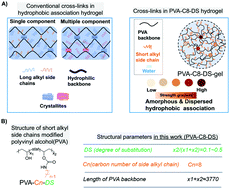Structural evolution of dispersed hydrophobic association in a hydrogel analyzed by the tensile behavior†
Abstract
The use of dispersed cross-links with different levels of strength is one of the most successful strategies for toughening a hydrogel. By using a model hydrogel having dispersed association of single-component short alkyl chains, this work demonstrates that the differential modulus–elongation relation derived from tensile curves can reflect the structural evolution of dispersed cross-links at a molecular level. This analysis method allows for decoupling the mechanical contribution of strong and weak hydrophobic clusters, which serve as the minor and major cross-links in our system, respectively. At small deformation, the weak hydrophobic associations majorly determine the stiffness, and their rupture releases folded partial chains to endow deformation capacity. At large deformation, the strength ratio of strong and weak hydrophobic association should be balanced to achieve the optimal strength. Furthermore, the structural parameters of these partial chains, including the Kuhn number, the Kuhn length and the chain conformation, are determined based on scaling theory of extensibility. These results allow for correlating the apparent mechanics to the structural parameters of the dispersed hydrophobic association, paving the way for customized mechanics for specific applications.



 Please wait while we load your content...
Please wait while we load your content...